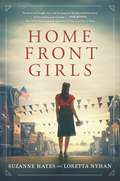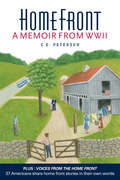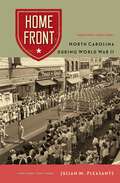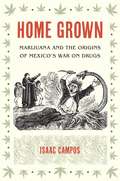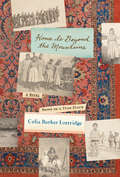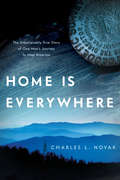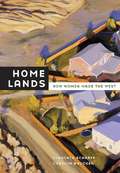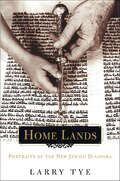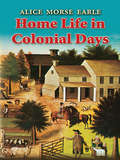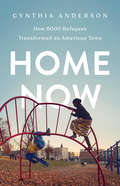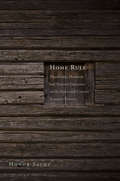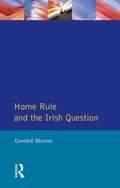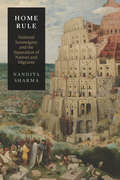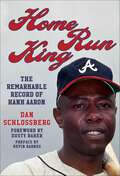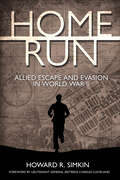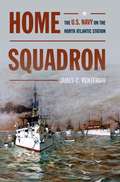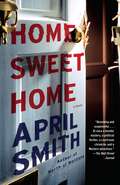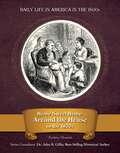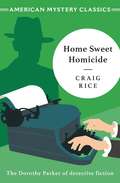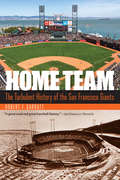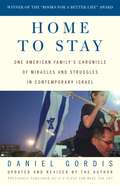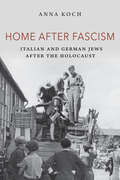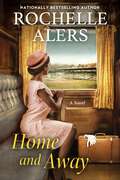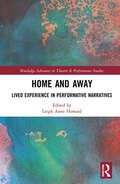- Table View
- List View
Home Front Girls
by Loretta Nyhan Suzanne HayesDear Glory,Loneliness is built into the fabric of this war, isn’t it? I say a little prayer before I stick my hand in the mailbox. The “Rockport, Massachusetts” stamp on the front of an envelope means the clouds will part, revealing a brilliant sun….It’s January 1943 when Rita Vincenzo receives her first letter from Glory Whitehall. Glory is an effervescent young mother from New England, impulsive and free as a bird. Rita is a Midwestern professor’s wife with a love of gardening and a generous, old soul. These two women have nothing in common except one powerful bond: the men they love are fighting in a war a world away from home.Brought together by an unlikely twist of fate, Glory and Rita begin a remarkable correspondence. The friendship forged by their letters allows them to survive the loneliness and uncertainty of waiting on the home front, and gives them the courage to face the battles raging in their very own backyards. Connected across the country by the lifeline of the written word, each woman finds her life profoundly altered by the other’s unwavering support.Filled with unforgettable characters and unbridled charm, Home Front Girls is a timeless celebration of the strength and solidarity of women. It is a luminous reminder that even in the darkest of times, true friendship will carry us through.Previously published as I’LL BE SEEING YOU.
Home Front: A Memoir From World War II
by C. D. PetersonPortrays the true story of the turbulence confronting an American farm family during and post-World War II. The compelling story is told in the voice of Douglas, the boy of the farm as he grows to an obliged maturity. An engaging narrator, he is among the last ones who personally experienced the scarcity of the depression, the fear and patriotism during World War II, and the exuberance in that brief, post-war period when America felt safe and when the middle class was born. After the war, with the GI Bill, VA loans, and fully stocked store shelves, the country was all about getting back to normal. But for some, normal was gone. This memoir chronicles a farm family and how normal evaded its reach.Home Front also includes Voices from the Home Front - 37 Americans sharing home front stories in their own words.
Home Front: North Carolina during World War II
by Julian M. PleasantsAt the outset of World War II, North Carolina was one of the poorest states in the Union. More than half of the land was rural. Over one-third of the farms had no electricity; only one in eight had a telephone. Illiteracy and a lack of education resulted in the highest rate of draft rejections of any state. The citizens desperately wanted higher living standards, and the war would soon awaken the Rip Van Winkle state to its fullest potential. Home Front traces the evolution of the people, customs, traditions, and attitudes, arguing that World War II was the most significant event in the history of modern North Carolina. Using oral history interviews, newspaper accounts, and other primary sources, historian Julian Pleasants explores the triumphs, hardships, and emotions of North Carolinians during this critical period. The Training and Selective Service Act of 1940 created over fifty new military bases in the state to train two million troops. Citizens witnessed German submarines sinking merchant vessels off the coast, struggled to understand and cope with rationing regulations, and used 10,000 German POWs as farm and factory laborers. The massive influx of newcomers reinvigorated markets--the timber, mineral, textile, tobacco, and shipbuilding industries boomed, and farmers and other manufacturing firms achieved economic success. Although racial and gender discrimination remained, World War II provided social and economic opportunities for black North Carolinians and for women to fill jobs once limited to men, helping to pave the way for the civil and women's rights movements that followed. The conclusion of World War II found North Carolina drastically different. Families had lost sons and daughters, fathers and mothers, and brothers and sisters. Despite all the sacrifices and dislocations, the once provincial state looked forward to a modern, diversified, and highly industrialized future.
Home Grown
by Isaac CamposHistorian Isaac Campos combines wide-ranging archival research with the latest scholarship on the social and cultural dimensions of drug-related behavior in this telling of marijuana's remarkable history in Mexico. Introduced in the sixteenth century by the Spanish, cannabis came to Mexico as an industrial fiber and symbol of European empire. But, Campos demonstrates, as it gradually spread to indigenous pharmacopoeias, then prisons and soldiers' barracks, it took on both a Mexican name--marijuana--and identity as a quintessentially "Mexican" drug. A century ago, Mexicans believed that marijuana could instantly trigger madness and violence in its users, and the drug was outlawed nationwide in 1920. Home Grown thus traces the deep roots of the antidrug ideology and prohibitionist policies that anchor the drug-war violence that engulfs Mexico today. Campos also counters the standard narrative of modern drug wars, which casts global drug prohibition as a sort of informal American cultural colonization. Instead, he argues, Mexican ideas were the foundation for notions of "reefer madness" in the United States. This book is an indispensable guide for anyone who hopes to understand the deep and complex origins of marijuana's controversial place in North American history.
Home Is Beyond the Mountains
by Celia LottridgeFinalist for the IODE Violet Downey Book Award Samira is only nine years old when the Turkish army invades northwestern Persia in 1918, and she and her parents, brother and baby sister are driven from their tiny village. Taking only what they can carry, they flee into the mountains, but the journey is so difficult that only Samira and her older brother, Benyamin, survive. When Samira finally arrives in a refugee camp, it is her friendship with another orphan, Anna, that pulls her out of her sadness. And when the two girls are given a toddler named Elias to care for, they form a new kind of family. Over the years the children are shunted from one refugee camp to another, from Persia to Iraq and back again, and finally end up in an orphanage, where it seems that they will live out their childhood. Then a new orphanage director arrives -- Susan Shedd, a woman whose authority and energy Samira has never seen before. And Samira’s respect turns to amazement when Miss Shedd decides that she will take the three hundred children back to their home villages to make new lives for themselves. It will be a journey of three hundred miles, through the mountains, and it will be made on foot.
Home Is Everywhere: The Unbelievably True Story of One Man's Journey to Map America
by Charles L. NovakAs a young man living in rural Kansas in the 1940s, Charles Novak took a job with the federal government—not because he liked the work but because he heard it paid well. That job shaped his life in ways he could never have imagined. As a surveyor for the U.S. Coast and Geodetic Survey, Charles was tasked with measuring the unmapped American landscape. Over the years this would take him from being eaten up by mosquitoes in Alaska, to eating steak and lobster on oil rigs in Louisiana. His career became even more adventurous when his family later hit the road with him, making their home in a caravan of trailers as the survey team traversed the nation. The measurements taken by Charles and the survey team eventually would go on to help build today's GPS technology. However, such a contribution was the furthest thing from the minds of Charles and his family as they experienced life on the road during a time of astounding change in American life. From segregated trains, to Cold War military bases, and back to Kansas, Charles's family found that home is more than a place on a map.
Home Lands: How Women Made the West
by Virginia Scharff Carolyn Brucken.Home Lands: How Women Made the West upends the view to remember the West as a place of homes and habitations brought into being by the women who lived there.
Home Lands: Portraits of the New Jewish Diaspora
by Larry TyeThe idea for this book came to Larry Tye as he traveled overseas as a reporter for the Boston Globe. In each city he visited he was intrigued by a reawakening of practice and spirit of the long repressed Jewish community. And the more communities he saw close-up, the clearer it became to him that the Jewish world was being reshaped and revitalized in ways that were not reflected in what he was reading about the disappearing diaspora and the vanishing Jews of America.The result is Home Lands, an narrative that tells the story of the new Jewish diaspora. Tye picked seven Jewish communities from Boston to Buenos Aires and Dusseldorf to Dnepropetrovsk deep in the Ukraine, and in each he zeroes in on a single family or congregation whose tale reflects the wider community's history and current situation. He met each community's leaders, talked with their scores of young people and old, and went with them to High Holiday services and Sabbath celebrations.The first impression that emerges from his travels is each city's uniqueness. Far more striking than the differences, however, is the unity. Jews all over the world still have enough customs and rituals in common for outsiders to see them as part of the same people, and for them to define themselves that way. It is that new comfort level, that sense of finally feel comfortable in the lands where they are living, that is at the heart of this engrossing book. Readers' eyes will be opened to how Germany, just a generation after the genocide, has the world's fastest-growing Jewish population; how the Jews of Buenos Aires have carved a place for themselves in a land that also gave refuge to Nazi henchmen like Adolph Eichman, and how Ireland is home to a tight-knit Jewish community that, remarkably, has produced Jewish Lord Mayors in Belfast, Cork and, twice from the same family, in Dublin. In Boston, Tye tells the story of his own family, whose roots run deep in the city's Jewish community.Home Lands is a book that is deeply personal even as it sheds light on the larger Jewish experience.
Home Life in Colonial Days
by Alice Morse EarleOriginally published in 1898, this is a classic work on life in colonial America. Earle, a noted social historian of her day, conducted extensive research into the folkways of the colonists, with special emphasis on colonial New England. She writes with warmth, enthusiasm, and understated humor, drawing frequently on letters and diaries of the time. Chapters cover weaving and spinning (described in detail), transportation, housing, hunting and fishing, social customs, flower gardens, and much more.
Home Life in Colonial Days
by Alice Morse EarleCould you identify a sausage gun if you had to? How about a plate warmer or a well-sweep? Any idea how the term log-rolling really originated? Alice Morse Earle (1851–1911), a prolific popular historian and the first American to chronicle everyday life and customs of the colonial era, describes what these and many other obscure utensils were and how they were used. She also conveys a vivid picture of home production of textiles, colonial dress, transportation, religious and social practices, the care of flower gardens, colonial neighborliness, and other aspects of early American life.Widely read when it was first published in 1898, this fascinating and wonderfully readable guide was instrumental in promoting a renewed interest in everyday life of bygone times. Today, it offers history buffs, collectors, and other interested readers a feast of delightful information.
Home Now: How 6000 Refugees Transformed an American Town
by Cynthia AndersonA moving chronicle of who belongs in America.Like so many American factory towns, Lewiston, Maine, thrived until its mill jobs disappeared and the young began leaving. But then the story unexpectedly veered: over the course of fifteen years, the city became home to thousands of African immigrants and, along the way, turned into one of the most Muslim towns in the US. Now about 6,000 of Lewiston's 36,000 inhabitants are refugees and asylum seekers, many of them Somali. Cynthia Anderson tells the story of this fractious yet resilient city near where she grew up, offering the unfolding drama of a community's reinvention--and humanizing some of the defining political issues in America today. In Lewiston, progress is real but precarious. Anderson takes the reader deep into the lives of both immigrants and lifelong Mainers: a single Muslim mom, an anti-Islamist activist, a Congolese asylum seeker, a Somali community leader. Their lives unfold in these pages as anti-immigrant sentiment rises across the US and national realities collide with those in Lewiston. Home Now gives a poignant account of America's evolving relationship with religion and race, and makes a sensitive yet powerful case for embracing change.
Home Rule
by Honor SachsOn America's western frontier, myths of prosperity concealed the brutal conditions endured by women, slaves, orphans, and the poor. As poverty and unrest took root in eighteenth-century Kentucky, western lawmakers championed ideas about whiteness, manhood, and patriarchal authority to help stabilize a politically fractious frontier. Honor Sachs combines rigorous scholarship with an engaging narrative to examine how conditions in Kentucky facilitated the expansion of rights for white men in ways that would become a model for citizenship in the country as a whole. Endorsed by many prominent western historians, this groundbreaking work is a major contribution to frontier scholarship.
Home Rule and the Irish Question (Seminar Studies)
by Grenfell MortonTaking the years 1800-1920, the book considers the four Home Rule Bills and discusses the role of leading figures such as Charles Stewart Parnell and Isaac Butt. This is a careful study of the rise in political consciousness- it addresses the relationship between nationalism and the Catholic faith, and popular support for the Union amongst Ulster Protestants- providing clear analysis of a troubled period.
Home Rule: National Sovereignty and the Separation of Natives and Migrants
by Nandita SharmaIn Home Rule Nandita Sharma traces the historical formation and political separation of Natives and Migrants from the nineteenth century to the present to theorize the portrayal of Migrants as “colonial invaders.” The imperial-state category of Native, initially a mark of colonized status, has been revitalized in what Sharma terms the Postcolonial New World Order of nation-states. Under postcolonial rule, claims to autochthony—being the Native “people of a place”—are mobilized to define true national belonging. Consequently, Migrants—the quintessential “people out of place”—increasingly face exclusion, expulsion, or even extermination. This turn to autochthony has led to a hardening of nationalism(s). Criteria for political membership have shrunk, immigration controls have intensified, all while practices of expropriation and exploitation have expanded. Such politics exemplify the postcolonial politics of national sovereignty, a politics that Sharma sees as containing our dreams of decolonization. Home Rule rejects nationalisms and calls for the dissolution of the ruling categories of Native and Migrant so we can build a common, worldly place where our fundamental liberty to stay and move is realized.
Home Run King: The Remarkable Record of Hank Aaron
by Dan SchlossbergIn the fifty years that have passed since Hank Aaron hit his 715th home run and supplanted Babe Ruth as baseball's home run king, his legend and legacy have only grown. Humble and modest to a fault, he always insisted that he didn't want people to forget Babe Ruth but only to remember Henry Aaron. Though he never had the benefit of playing in the media spotlight of New York or Los Angeles, he remains the career leader in total bases, runs batted in, and All-Star selections; shares records for home runs by brothers (with Tommie Aaron) and by teammates (with Eddie Mathews); and is remembered with respect and admiration for his outspoken advocacy of civil rights for all minorities. Written by a lifelong Braves fan who became a sportswriter, this book traces Aaron's odyssey from the segregated south to the baseball world revolutionized by Jackie Robinson, who became an early an important ally against bigotry and prejudice. It reveals how the New York Giants nearly beat the Boston Braves in signing Aaron, when the young slugger caught his first break, and why he changed his hitting style after the Braves moved from Milwaukee to Atlanta. Though he never won a Triple Crown or hit for the cycle, he won virtually every major honor, including an MVP award, a World Series ring, and a berth in the Baseball Hall of Fame. But he should have won more, as the author contends he was often taken for granted by voters (nine of whom left him off their Cooperstown ballots!). Turn these pages to find out what home run Aaron considered his greatest, what pitcher proved his easiest mark, and what managers he liked or disliked the most. Even the disappointments are included -- his team's move south, its inability to establish a dynasty, and his quests to become a manager, general manager, or even Commissioner of Baseball. This is also a book of personal tragedy: the death of a child, a difficult divorce, and the stunning loss of the 43-year-old brother-in-law who became the first black GM. Not to mention the deluge of hate mail as it became obvious that he was approaching the most cherished record in sports. Through it all, Henry Louis Aaron kept his composure, preferring to let his bat do the talking. He lacked the notoriety of Willie, Mickey & the Duke but he just might have been the best player in baseball history. He's certainly in the conversation.
Home Run: Allied Escape and Evasion in World War II
by Howard R. Simkin"This book belongs on every World War II bookshelf, filling in the gaps on what is known about this oft-mentioned but little understood topic of wartime escape and evasion." —The NYMAS ReviewImagine that you are deep behind enemy lines. Your plane was shot down or perhaps you have just escaped from a prisoner of war camp. The enemy is hunting you, seeking to throw you behind barbed wire for the duration of the war. What will you do? Do you have a plan, and the skills, to make it to friendly territory? During World War II, the Germans and Japanese held over 306,000 British and 105,000 U.S. service members as prisoners. The number of successful evaders and escapers, both U.S. and British, exceeded 35,000. Many of these were aircrew, who received intense training because of the high risk that they would have to evade or escape. This book will relate how they fared in enemy hands or managed to remain free. This book provides a complete overview of U.S. and British escape and evasion during World War II. It tells the story of the escape and evasion organizations, the Resistance-operated lines, and the dangers faced by the escapers and the evaders in a logical and compelling narrative. Heroism, betrayal, sacrifice, and cowardice are all elements of this fascinating part of the rich tapestry of World War II.
Home Squadron
by James C. RentfrowThis study examines the transformation of the United States Navy as a fighting organization that took place on the North Atlantic Station between 1874 and 1897. At the beginning of this period, the warships assigned to this station were collectively administered by a rear-admiral, but were operationally deployed as individual units, each of whose actions were directed by their captains. By 1897 the North Atlantic, or "Home" Squadron as it was known, was a group of warships constituting a protean battle fleet - that is, an organized body moving and fighting in close-order, which meant that the actions of the captains were directed by a commanding admiral. The process of the development of an American battle fleet resulted in the construction of a new organizational identity for the North Atlantic Squadron. This process was as critical as the eventual outcome. It was not linear, but one in which progress in critical areas was modulated by conflicting demands that caused distraction. From 1874-1888, exercises in fleet tactics under steam were carried out sporadically utilizing existing wooden cruising vessels. From 1889-1894, the last wooden cruisers were decommissioned and the Squadron consisted entirely of new steel warships. Ad-hoc concentrations of vessels for purposes besides exercise and training retarded the continued development of doctrine and tactics necessary for a multi-ship fighting capability during this time. However, much work was done to develop a concept of multi-ship operations. From 1895-1897, the identity of the North Atlantic Squadron as a combat unit solidified. Tactical exercises were held that had specific offensive and defensive wartime applications. These exercises were necessary to develop a combat capability. The results of this study demonstrate that the United States government had an interest in developing an offensive naval combat capability as early as the 1870's. Based on the record of the North Atlantic Squadron, it is argued that imperial aspirations, in the sense of possessing a capability to restrict the actions of other great powers in the Caribbean region, existed prior to the War of 1898. However, the process of change often resulted in the appearance of capability without the rigorous exercise necessary to possess it.
Home Sweet Home: A novel
by April SmithFrom the widely praised author of the FBI Special Agent Ana Grey series and A Star for Mrs. Blake, this riveting epic drama follows the Kusek family from New York City to America's heartland, where they are caught up in the panic of McCarthyism, a smear campaign, a sensational trial, and, ultimately, murder.Calvin Kusek, a WWII pilot and attorney, and his wife, Betsy, escape the 1950s conformity of New York City to relocate to a close-knit town in South Dakota. They settle on a ranch and Betsy becomes a visiting nurse, befriending a quirky assortment of rural characters. Their children, Jo and her brother Lance, grow up caring for animals and riding rodeo. Life isn't easy, but it is full and rewarding. When a seat in the State Assembly becomes available, Cal jumps at the chance to repay the community and serves three popular terms. Things change when Cal runs for the U.S. Senate. The FBI investigates Betsy, and a youthful dalliance with the Communist Party surfaces to haunt the Kuseks. Mass hysteria takes over, inflamed by Cal's political enemies. Driven by fear and hate, their neighbors turn, condemning them as enemies and spies. The American Dream falls apart overnight as the Kuseks try to protect their children from the nightmare that follows. The family is vindicated in a successful libel lawsuit, but the story doesn't end there: years later, Lance Kusek and his wife and son are brutally attacked, and the mystery then unfolds as to who committed this coldblooded murder, and are they related to the stunning events of decades earlier?From the Hardcover edition.
Home Sweet Home: Around the House in the 1800s (Daily Life in America in the 1800s)
by Zachary ChastainIn rough frontier cabins, tidy farmhouses, and elegant townhouses, Americans in the 1800s were dedicated to living as well and as comfortably as their circumstances allowed. The American home was a sacred institution, the seat of family life where the patriarch ruled with Mother at his side as guardian of the home, and the children were raised with strict discipline and strong values. Changes in taste and fashion, improvements in technology (indoor plumbing and a host of new labor-saving devices), and social change transformed home and family life in the 1800s, as opportunities for leisure activities and commercially produced consumer goods came within reach of the average American. But the strong American tradition of the sanctity of the home, consumerism, and the importance of a happy family life has its roots in the homes of nineteenth-century Americans.
Home Sweet Homicide
by Craig RiceA crime writer's family witnesses a real-life murder - the neighbourhood just got dangerous...Perfect for fans of KNIVES OUT'There was never anyone else like Craig Rice' NEW YORK TIMESGrowing up with a crime writer for a mother leaves the Carstairs family with a talent for detection. So when they witnesses a neighbourhood murder, they launch their own investigation. And why not? They know everything about baffling mysteries from reading their mother's books, the publicity could do wonders for her sales, and then she and a handsome detective could fall in love. It's too perfect for words.Marion's too busy wrapping up the loose ends of her latest book for the inconvenience of a real crime. But what's surfacing in the shadows of the house next door is not quite as predictable as fiction: accusations of racketeering, kidnapping and blackmail - and much more...
Home Team: The Turbulent History of the San Francisco Giants
by Robert F. GarrattIn 1957 Horace Stoneham took his Giants of New York baseball team and headed west, starting a gold rush with bats and balls rather than pans and mines. But San Francisco already had a team, the Seals of the Pacific Coast League, and West Coast fans did not immediately embrace the newcomers. Starting with the franchise’s earliest days and following the team up to recent World Series glory, Home Team chronicles the story of the Giants and their often topsy-turvy relationship with the city of San Francisco. Robert F. Garratt shines light on those who worked behind the scenes in the story of West Coast baseball: the politicians, businessmen, and owners who were instrumental in the club’s history.Home Team presents Stoneham, often left in the shadow of Dodgers owner Walter O’Malley, as a true baseball pioneer in his willingness to sign black and Latino players and his recruitment of the first Japanese player in the Major Leagues, making the Giants one of the most integrated teams in baseball in the early 1960s. Garratt also records the turbulent times, poor results, declining attendance, two near-moves away from California, and the role of post-Stoneham owners Bob Lurie and Peter Magowan in the Giants’ eventual reemergence as a baseball powerhouse. Garratt’s superb history of this great ball club makes the Giants’ story one of the most compelling of all Major League franchises.
Home To Stay: One American Family's Chronicle of Miracles and Struggles in Contemporary Israel
by Daniel GordisIn the summer of 1998, Daniel Gordis and his family moved to Israel from Los Angeles. They planned to be there for a year, but a few months into their stay, Gordis and his wife decided to remain in Jerusalem permanently, confident that their children would be among the first generation of Israelis to grow up in peace. Immediately after arriving in Israel, Daniel had started sending out e-mails about his life to friends and family abroad. These missives—passionate, thoughtful, beautifully written, and informative—began reaching a much broader readership than he’d ever envisioned, eventually being excerpted inThe New York Times Magazineto much acclaim. An edited and finely crafted collection of his original e-mails,Home to Stayis a first-person, immediate account of Israel’s post-Oslo meltdown that cuts through the rhetoric and stridency of most dispatches from that country or from the international media. This is must reading for anyone who wants to get a firsthand, personal view of what it’s like for a family on the front lines of war.
Home after Fascism: Italian and German Jews after the Holocaust (The Modern Jewish Experience)
by Anna KochHome after Fascism draws on a rich array of memoirs, interviews, correspondence, and archival research to tell the stories of Italian and German Jews who returned to their home countries after the Holocaust. The book reveals Jews' complex and often changing feelings toward their former homes and highlights the ways in which three distinct national contexts—East German, West German, and Italian—shaped their answers to the question, is this home? Returning Italian and German Jews renegotiated their place in national communities that had targeted them for persecution and extermination. While most Italian Jews remained deeply attached to their home country, German Jews struggled to feel at home in the "country of murderers." Yet, some retained a sense of belonging through German culture and language or felt attached to a specific region or city. Still others looked to the future; socialist and communists of Jewish origin hoped to build a better Germany in the Soviet Occupied Zone. In all three postwar states, surviving Jews fought against persistent antisemitism, faced the challenge of recovering lost homes and possessions, struggled to make sense of their persecution, and tried to find ways to reclaim a sense of belonging. Wide ranging and moving, Home after Fascism enriches our understanding of Jews' homecoming experiences after 1945. It reveals the deep affection and persistent love people feel for their homes, the suffering that comes with losing them, and the challenges of a return.
Home and Away
by Rochelle AlersSpanning more than eighty years, from Memphis in the 1930s and 1940s to present-day Chicago, this sweeping novel draws on the turbulent history of the Negro Baseball Leagues, as the great-granddaughter of a former player sets out to tell her family&’s story—and redefine her own. Harper Fleming is done with being passed over. As a journalist for a Chicago newspaper, she&’s been refused a shot at the sportswriter position she longs for. And her on again/off again relationship is going nowhere. Leaving both behind, she heads to Nashville, Tennessee, where she plans to interview her widowed grandfather, Bernard Fleming, for a book about his father Kelton Fleming&’s time in the Negro Baseball Leagues. When Bernard reveals health issues within days of her arrival, Harper assumes responsibility for taking care of him. And when she mentions his father playing baseball in the Negro Leagues, Bernard gives her a trove of letters, journals, and clippings encompassing Kelton&’s career. But some stories are too personal to print without dishonoring the memory of her great-grandmother. Instead, with Bernard&’s approval, Harper begins weaving them into a novel, telling her great-grandfather&’s story through the eyes of the fictional Moses Gillian. Chapters flow effortlessly as Harper breathes life into each memory. Particularly intense are Kelton&’s recollections of the Green Book, an annual guidebook that helped African Americans navigate the segregated South. Negro League teams relied on it as they traveled between games, hurrying out of unwelcoming towns before sundown to avoid the Klan. As Harper delves into Kelton&’s past, a piece of her own resurfaces in the form of Cheney, the childhood friend of her brothers&’. And as Harper honors her great-grandfather&’s life, she finds the inspiration to take her own in a bold new direction . . .
Home and Away: Lived Experience in Performative Narratives (Routledge Advances in Theatre & Performance Studies)
by Leigh Anne HowardHome and Away explores how performative writing serve as a process that critically interrogates space/place in relation to personal, social, cultural, and political understanding. By combining aesthetic expression and inquiry with critical reflection, the contributors in this volume use a variety of narrative strategies—autoethnography, mystoriography, creative cartography, the lyric essay, fictocriticism, collage, the screenplay, and poetics—to position place as the starting point for the aesthetic impulse. The anthology showcases the power and potential of performative writing to illustrate the ways we interact with and in place; provides examples of the ways one can express lived experience; and demonstrates the ways discourses overlap while extending our understanding of identity and place, whether one is home or away. Although the chapters are fixed by their literary form in this volume, many of chapters are best realized in a performance or shared publicly via an oral tradition. This collection will be of great interest to students and scholars in performance, communication studies, and literature.
